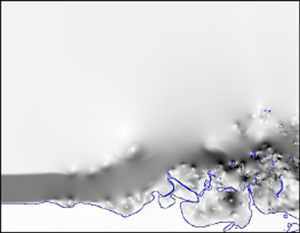Article contents
Stability of an air–water mixing layer: focus on the confinement effect
Published online by Cambridge University Press: 21 December 2021
Abstract

The shear instability occurring at the interface between a slow water layer and a fast air stream is a complex phenomenon driven by momentum and viscosity differences across the interface, velocity gradients as well as by injector geometries. Simulating such an instability under experimental conditions is numerically challenging and few studies exist in the literature. This work aims at filling a part of this gap by presenting a study of the convergence between two-dimensional simulations, linear theory and experiments, in regimes where the instability is triggered by the confinement, i.e. finite thicknesses of gas and liquid streams. It is found that very good agreement between the three approaches is obtained. Moreover, using simulations and linear theory, we explore in detail the effects of confinement on the stability of the flow and on the transition between absolute and convective instability regimes, which is shown to depend on the length scale of the confinement as well as on the dynamic pressure ratio. In the absolute regime under study, the interfacial wave frequency is found to be inversely proportional to the smallest injector size (liquid or gas).
- Type
- JFM Papers
- Information
- Copyright
- © The Author(s), 2021. Published by Cambridge University Press
References
REFERENCES
- 8
- Cited by



